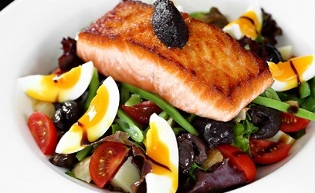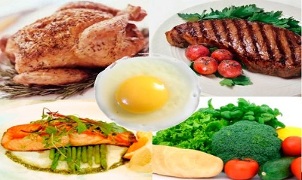How many times have you spent re-reading highly effective diets that help remove subcutaneous fat? Do you know why there are over 10, 000 options for various weight loss activities in the world? It’s simple: because 90% of them are ineffective. A protein diet is a good option for weight loss, but it can also be ineffective if used incorrectly. How to use proteins for weight loss without harming your health with maximum results?
How to lose weight on a protein diet?
To get rid of subcutaneous fat, you need to know the physiological needs of the body, understand when carbohydrates can be eaten and when proteins can be eaten, and be able to listen to your body, which gives an unlimited number of tips, in case we do the wrong diet.
Surely most of you already know that if you limit the intake of sweet and complex carbohydrates, significant weight loss can be achieved, the specific figure depends on the percentage of fat in the human body. This can be called a low-carb diet, a very effective way to get rid of fat. The calorie deficit created by minimizing carbohydrate intake is completely replenished with fat. That is why people are losing weight by limiting the use of carbohydrates in their diet.
What happens if we remove carbohydrates from the diet completely?
Will we find a better way to lose weight? Our answer: of course, yes. This diet was very popular during the golden age of bodybuilding and was widely promoted by Vince Gironde. All you have to do is look at his photo and it will be immediately clear why he recommended it. This one of the best methods, according to many nutritionists, is called a protein diet.

A Protein Weight Loss diet is a carbohydrate-free diet that consists only of healthy protein and fats foods for the body. Carbohydrate calories are fully compensated by animal protein. This approach allows not only to get rid of fat as efficiently as possible, but also to speed up metabolism and preserve muscle tissue as much as possible.
Many diets practically do not take into account the latter two aspects: their main goal is simply to reduce the total daily calorie intake, which does not have a very positive effect on the condition of a person who is losing weight.
The body considers a sharp decrease in calorie intake as a threat to life, begins to reduce metabolism and transports all consumed food to subcutaneous fat, using muscle fibers for energy consumption. So it happens that at the end of this method a person creates to lose weight, ideal conditions for gaining fat and does everything to burn muscle mass. We hope now that you have lost the desire to try the famous coin diets?
Basic principles of the protein diet
When we create an environment where carbohydrates are completely absent, bodies begin to release ketones from subcutaneous fat, which are the main source of energy for the brain and nervous system.
To make it clearer, it is necessary to explain that all the foods we eat contain more or less three nutrients, each of which fulfills its own function of supporting the life of the body. These are fats, proteins and carbohydrates:- Proteinis a building material for our body, because energy is used in very rare cases.
- Fatstores energy stored for emergencies, while fat is also used to protect internal organs.
- Carbohydratesare fully responsible for our body's energy supply.
Now it's clearer why do we want to eat sugary or complex carbohydrates when we're hungry? Because carbohydrates are the main source of energy for our body, and proteins and fats remain in reserve. Therefore, in everyday life, so you want to eat sweet and complex carbohydrates: this is the most effective way to provide energy to the body. And that’s why people don’t like to exclude foods that contain carbohydrates from their diet. The body does not realize that a person deliberately excludes the main source of energy. Your body thinks you are in harsh living conditions and expects hunger. If carbohydrates do not start flowing in the shortest possible time, the body will be forced to unpack the emergency reserves of fat.
What happens if you continue to limit your carbohydrate intake?
First, your body will use up all its glycogen stores, which will last for a short time, and only later will it completely switch to autonomous nutrition due to proteins and fats. Thanks to this method of losing weight, there are a large number of positive reviews of the protein diet from people who have achieved incredible results. To be honest with you, everyone in the world of diet has a foundation with the protein method to lose weight. Read any coin diet carefully, and between the lines you will see the basic elements we are covering in our article. Of course, if the author of the diet, which you will be reading, presented it correctly.
It is important to add the important point that a person 's blood glucose will not rise if you leave about 50 grams of carbohydrates on a strict protein diet. This means that the body will continue to feed adipose tissue to ensure a positive energy balance in the body.
Should you eliminate carbohydrate intake on a protein diet?
There are many advantages and one small minus in this conclusion. The positive side is that glycogen stores are quickly depleted as a result of complete elimination of carbohydrates, and this encourages the body to start using fat stores as soon as possible. And the reason for everything is our old friend’s insulin. Its presence or absence determines what type of energy the body consumes. Everything is simple here: the less carbohydrates you eat, the less insulin is run. The surge of this hormone completely blocks the lipolysis process (breakdown of adipose tissue). It can be concluded that a protein diet eliminates the insulin surge and activates the full effect of lipolysis.
What is the biggest disadvantage of a protein diet?
In order to maintain the normal functioning of the digestive system, it is necessary to eat at least occasionally fiber, which is found where? That's right, in carbohydrates. Failure to do so can lead to problems such as constipation, which is completely unpleasant news. Therefore, we strongly recommend that you do not exclude vegetables like cucumbers, tomatoes and cabbage from the diet on a protein diet. They will keep your gastrointestinal tract fully functional.The damage done to a protein diet
The harm of a protein diet can only be done if you start eating too much protein and getting rid of fiber from the diet completely. And all these actions will be applied for a long time, then dysfunctions in the body will begin. We strongly recommend that you consult your doctor and dietitian before using the above scheme. Because there is an impressive list of diseases that can only be accepted protein foods. Good health to everyone and finally become the owners of the prettiest figure in your city.
How long is the protein diet?

- There is a choice for a continuous diet: for a long time you only eat proteins, healthy fats and fiber.
- Power Dietis only used on training days. You do a carbohydrate load about two hours before your workout to provide glycogen and significantly increase your fitness intensity. Every other day a protein diet.
- Cyclical use of protein diet. This option provides a carbohydrate load once a week during the day. This will help preserve muscle mass for as long as possible and further boost metabolism. This is the way we are encouraged by all who want to make the body worthy of its spirit. While you can try the most suitable option for yourself.
What to eat with a protein diet: food
The answer will probably not surprise you if we say that these should be foods that contain animal protein. Lean meats are best used as veal, beef, chicken breeds, and rabbit. From dairy products, choose foods that are low in fat, but you should only eat low-fat kefir. A fat content of up to 10% is quite suitable. This is normal, no need to worry. “Remember, fats are burned on a carbohydrate fire. ” Be sure to eat fish: not only is it high in protein, but it is also a source of healthy omega fats. Don’t forget about eggs as a benchmark for assimilation among all of the above products.
5 to 10 meals a day should, in fact, the better. This is why all food must be prepared in the morning and distributed evenly in the bowls: this allows a container to be opened with food at any time of the day and the required amount of food to be eaten.
Sample menu for the week
This is what a 7 day protein diet menu will look like, or it can be extended by 14 days.
Monday
- packaging of fat-free cottage cheese; jar of yogurt
- , 1 grapefruit;
- 2 chicken breasts, broccoli, half a glass of kefir;
- jar of yogurt, medium grated carrots;
- 1 liter of still mineral water, glass of natural apple juice.
Tuesday
- yogurt
- , green apple;
- 100 g of any meat, cheese, tomatoes, 1 bell pepper;
- 200 g fish, celery salad, carrots and ½ apple;
- 2 hard boiled eggs, cabbage salad with parsley and lemon juice;
- 1 liter of water, 1 glass of currant juice.
Wednesday
- yogurt
- , glass of strawberries; Granulated cottage cheese
- by adding a spoonful of chopped parsley, red pepper and tomato paste;
- 2 chicken breasts, a cup of spinach, half a cup of kefir;
- one stew, zucchini, 1 tomato, 2 tablespoons dill (you can mix vegetables and add 2 tablespoons of olive oil), 2 slices of ham;
- 1 liter of water, glass of orange juice.
Thursday
- packaging of fat-free cottage cheese;
- glass of kefir, ½ cup of raspberries; Stew
- 200 g, 1/3 cup milk, carrots;
- 2 eggs, cabbage salad with paprika and parsley, seasoned with lemon juice;
- 1 l. water, a glass of currant juice.
Friday
- yogurt
- , 2 tangerines; Granulated cottage cheese
- (1 pack);
- 200 g sea fish, tomatoes, red pepper and parsley salad, yogurt; Granulated cottage cheese
- (1 pack), carrots, green apple;
- 1 liter of water, glass of orange juice.
Saturday
- 100 g cottage cheese, skim milk;
- glass of kefir;
- 2 chicken breasts, beans, yogurt;
- 2 slices of ham, broccoli, 1 egg, 2 tablespoons cereal;
- 1 l. water, a glass of currant juice.
Sunday
- glass of kefir, ½ cup of raspberries (or other berries); grainy curd, a slice of ham; stewed chicken liver
- , lettuce with lemon juice, apple; yogurt
- with extra fruit;
- 1 liter of water, glass of apple juice.














































































